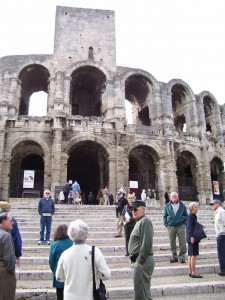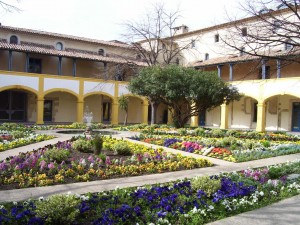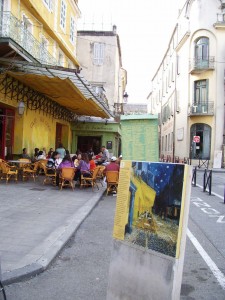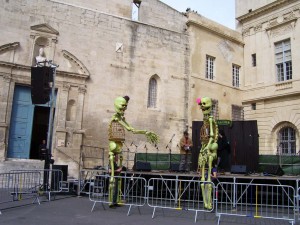THE RIVERS OF FRANCE – FOLLOWING VINCENT VAN GOGH IN ARLES
THE RIVERS OF FRANCE
This is the fourth in a series of articles about a boat trip along the Rhone River
FOLLOWING VINCENT VAN GOGH IN ARLES
By Charles N. Stevens
Photos by Dolores Seidman
We leave Avignon by bus for a day in Arles (pronounced “Arl”) where the painter Vincent Van Gogh once lived and painted. We cruise by Avignon’s grim city walls, the Rhone River on our left looking curiously olive and silver in the morning light.
On our way we notice that the road signs are both in French and Provencal. Rather than a dialect, the French consider the latter to be a separate language. Our bus rolls through flat agricultural land, passing orchards of apricots and peaches, rich green wheat fields and curved plastic shelters protecting tender vegetables like lettuce and herbs. We catch a glimpse of the famous gray, almost white, Camargue horses. These horses, known for their strength, once roamed wild in the Camargue, the former marshy area between the Petite Rhone and the Grand Rhone.
Once in Arles, we stand on the bank of the Rhone where Inflatable Water Slide Van Gogh painted views of the river and the city. Standing on the very spot where such a revered painter filled his canvasses is very exciting. In one direction stand two great stone lions that once guarded the entrance to a bridge across the Rhone, bombed by the Allies during the war and never rebuilt. Van Gogh had preserved this bridge in his painting “Arles by Night”. Turning to our right and gazing off in the distance we can see the site of Van Gogh’s yellow house where he once lived. The house no longer exists, but the railroad trestle over the road close to his house is still here. But even the trestle is inactive, the rails long torn up and replaced by weeds and scrawny trees.
Van Gogh was attracted to Arles because of its sun, clear blue skies like those of today and color. He painted two hundred canvasses in Arles in 1888 and 1889, loading his brush with bright colors depicting cafes, people, harvests and orchards of the area.
Later we walk into town between two crumbling towers, all that is left of their city walls, to a spot on a narrow street where Van Gogh painted so many of his bar and café scenes. Of course the cafes are gone, replaced by more modern buildings.
Only a few blocks away stands the two thousand year old Roman Amphitheater, now weathered and stained by time but still solid. We stand under the great stone arches that support it, one of many arches that allowed the Romans to evacuate the structure in just over five minutes. Double arches make it remarkably sturdy. Gladiator fights were staged here until the year 404 when Christians put a stop to it. The French still use it for bull fights. At one type of contest the bull is killed just as in Spanish bullfights. In another version, men pluck ribbons off of the upturned horns of Camargue bulls. The fights are only held twice per year for three or four days.
The Romans could cram twenty thousand people into this stadium, but it now seats half as many. Not wanting to be classed as a tourist painter, Van Gogh painted only one picture of the stadium, showing the arena in yellow and the crowds rather indistinct.
Nearby is the Roman Theater dedicated in 12 BC by Augustine in honor of the god Apollo. Its twenty seven rows and three levels are still used for performances. Unfortunately a number of stones were stolen from it to build Christian churches. We learn too that most of modern Arles is built over the ancient Roman Forum, the stones still buried beneath its buildings. It is difficult to realize that this place was one of the favorite vacation spots of Caesar and Constantine.
Off a small square featuring a green statue of the poet Mistral is the café Van Gogh illustrated in his painting, “Le Café le Soir”. Its walls, canopy, chairs and table cloths are bright yellow, one of Van Gogh’s favorite colors. It is now called “Le Café la Nuit” but keeps the colors that the painter favored. A small billboard of his painting stands just outside the railing. Inside the cafe, Japanese tourists occupy most of the seats.
As tourists we have been immersed in Roman antiquities and the life of Vincent Van Gogh all day. In contrast it is refreshing to spot bits of modern French life, a young woman walking by with a half dozen baguettes, paper wrapped around their middle, a cook standing outside a café stirring chicken pieces in a cauldron of oil— smoke and fragrance rising, drifting down the street.
In a nearby square we come upon a remarkable sight, a huge 10 foot high skeleton puppet, its bones a pale chartreuse. A young woman straps herself between its legs, the bones towering over her. With sticks she manipulates its arms and fingers, even making it wave, fingers flopping. Actually there are two skeleton puppets. The female wears a red ribbon on her skull, the male a derby, a cigar in his mouth. It is amazing how they walk, move their arms in a very human way.
To finish off with Van Gogh, we enter the grounds of the Hotel Dieu, a municipal building where he was brought after he cut off part of his ear in a fit of emotion. Before this “accident” he painted the expansive patio with its gardens and trees. Today it is kept the exact way it was depicted in the painting. Even the trees are bare the way they were in the painting. The fountain and pool are the same. Maintaining the patio this way is a tribute to the artist that is still revered by the city.

Arles' 2000 year-old Roman Stadium is still used.

This is the exact setting of Van Gogh's painting, "Hotel Dieu."

Van Gogh painted this very cafe, calling it "Le Cafe le Soir."

We are amazed to see these large skeletons walking in the square




Interesting article Norm! Good pictures Dolores! I’d love to enjoy what you enjoyed there. France is one of my favorite places and Van Gogh is a favorite artist.
Wonderful article. Had no idea Arles had been such a popular Roman spot, and their structures still stand (and are used ) today. Photos make it all come alive–esp the skeletons!!!! One of your best articles ever!